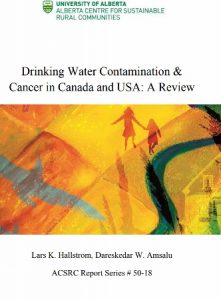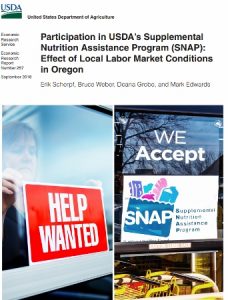Reports: August 2018
Hallstrom, L. K., & Amsalu, D. W. (2018). Drinking Water Contamination & Cancer in Canada and USA: A Review (p. 25). University of Alberta.
 The contamination of drinking water is a major cause of global public health problems including enteric disease, cancer (Meliker & Nriagu, 2007; Christoforidou et al., 2013) and acute gastrointestinal illness (OECD/WHO, 2003). In Canada, while both drinking water quality and
The contamination of drinking water is a major cause of global public health problems including enteric disease, cancer (Meliker & Nriagu, 2007; Christoforidou et al., 2013) and acute gastrointestinal illness (OECD/WHO, 2003). In Canada, while both drinking water quality and
supply are issues (Murphy et al., 2016), there is particular attention in western Canada to the implications of water-based contaminants for human health. The purpose of this report is to present the lessons learned from the peer-reviewed research that assessed health impacts of drinking water contamination in the United States and Canada.
We reviewed and analyzed 64 published articles (11 in Canada and 53 in the USA) to identify: (1) the most common water contamination indicators; (2) associated health risks; and (3) methods used in the studies. Arsenic contamination and bladder cancer were by far the most commonly used indicators. A second synthesis was then undertaken based on 7 articles to evaluate the studies that specifically assessed this association.
Population-based, case-control studies along with statistical regression was the most commonly applied approach for assessing the association between arsenic and bladder cancer. While studies (n=5) that considered large arsenic samples and/or controlled for the confounding risk factors found statistically significant associations between bladder cancer and exposure to low-to-medium levels (e.g., 10-100 μg/L) of arsenic in drinking water, studies (n=2) that considered relatively small arsenic samples and/or did not control for the confounding risk factors found insignificant associations. Our review suggests that the association between bladder cancer and low-to-medium levels of arsenic in drinking water needs to be assessed by following appropriate quality criteria and using commonly applied study designs and methods. These include using population-based, case-control design, considering different arsenic exposure metrics, incorporating large sample size, controlling for confounding risk factors, and adjusting for demographic covariates.
Scherpf, E., Weber, B., Grobe, D., & Edwards, M. (2018). Participation in USDA’s Supplemental Nutrition Assistance Program (SNAP): Effect of Local Labor Market Conditions in Oregon (No. 257) (p. 56). USDA.

Abstract
This study investigates the relationship between local economic conditions in Oregon and spell lengths of USDA’s Supplemental Nutrtion Assistance Program (SNAP). Using different indicators of economic conditions and different definitions of local labor market areas, the report finds evidence that improved labor market conditions were associated with an increased probability that a SNAP recipient in Oregon ended a participation spell. When local labor markets are delineated as commuting zones—our preferred definition—our results suggest that a 10-percent increase in local employment raises the average recipient’s probability of program exit by nearly 7 percent. The report shows that—when labor market conditions are measured in a more localized way than is typically done—SNAP recipients are found to be more responsive to labor market conditions.
